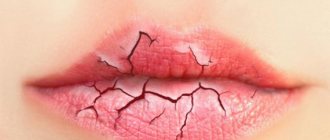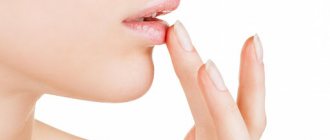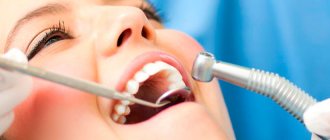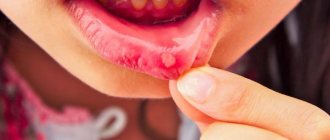June 01, 2020
Cheilitis is an inflammatory process that affects the border, mucous membrane and skin of the lips. The disease has a long-term recurrent nature.
Cheilitis is an inflammatory process that affects the border, mucous membrane and skin of the lips. The disease has a long-term recurrent nature. In young people, the course is more favorable and self-healing is possible. In old age there is a risk of leukoplakia and malignancy.
Symptoms of cheilitis
The disease manifests itself in a variety of symptoms; common complaints include swelling, redness, peeling of the lips, the appearance of bleeding ulcers, purulent crusts, burning and pain when opening the mouth and eating.
There are several forms of this pathology:
- Catarrhal
- Glandular
- Exfoliative
- Eczematous
- Candida
- Allergic
The causes of catarrhal cheilitis are usually injuries, weather conditions, and chemical damage. This form of the disease manifests itself in the form of diffuse inflammation of the lips, swelling, redness, and peeling.
With glandular cheilitis, the mucous glands of the lips become inflamed. The disease can occur against the background of injuries with the addition of infection. The presence of bad habits can also contribute to the development of this form of cheilitis.
The disease manifests itself as enlarged glands, discharge of pus, and increased lip volume. Often, as a result of such an inflammatory process, the lips do not restore their previous shape, since changes in the form of cysts form in the labial glands.
Exfoliative cheilitis is divided into dry and exudative. Exfoliative cheilitis is more common in women. With dry exfoliative cheilitis, yellow scales appear on the lips and dryness is pronounced. In addition, the red border of the lips is affected by dyskeratosis.
The exudative form of exfoliative cheilitis is characterized by severe pain, swelling of the lip, and the presence of abundant crusts that make speech and eating difficult. Sometimes the crusts hang down in the form of an apron when the exudative phenomena are significant. Candidal cheilitis is provoked by the fungal infection Candida albicans, and this form of the disease is often combined with stomatitis.
Various allergens can cause another form of cheilitis - eczematous. This type of cheilitis occurs when there is an allergy to cosmetics, a lack of B vitamins in the body, or chronic injury to the lips. In addition, allergic (eczematous) cheilitis occurs due to increased sensitivity of the red border of the lips to chemicals (for example, dyes) included in toothpaste, lipstick, and dentures. It occurs with swelling and redness of the red border of the lips, then becomes covered with abundant scales and crusts, and painful cracks form in places.
Atopic
This disease is one of the symptomatic manifestations of atopic dermatitis. Characteristic signs are redness, slight swelling, itching, peeling of the skin in the red border area, as well as the spread of the inflammatory process to the corners of the lips, where cracks often form.
The cause is considered to be genetic abnormalities and poor heredity. By puberty, atopic cheilitis can heal itself or go into remission, but recurrent seasonal lesions cannot be ruled out. Allergens can be food, cosmetics, medications and many other factors.
Prevention
As you know, prevention is cheaper than treatment. In addition, preventing a disease is much easier than curing it, although this will require regularly following some rules.
Pay more attention to oral hygiene. To prevent the formation of cracks, it is necessary to protect the skin and mucous membranes of the mouth from adverse effects: unlearn the habit of licking the lips and corners of the mouth, use medicinal cosmetics for dry skin (lipstick, balm, cream). To avoid infection of the skin of the lips from the oral cavity, it is necessary to regularly brush your teeth, see a dentist, and promptly treat caries and inflammatory gum diseases.
Follow the rules of nutrition. If cracks appear in the corners of the mouth, exclude from the diet spicy, sour and salty foods that irritate the mucous membrane and skin. Include less acidic fruits and vegetables in your daily diet, as well as foods containing iron and riboflavin (beef, liver, dairy products, cabbage, potatoes, peanuts, almonds and others).
Give up bad habits. Smoking is a provoking factor in the development of this disease.
Prevention of cheilitis in adults at home
It is especially important to adhere to the rules for preventing cheilitis at home if you are predisposed to the disease and its complications: with food allergies or reactions to cosmetics, dermatoses, chronic endocrine diseases, or with dentures. The rules are quite simple:
- regular visits to the dentist for oral hygiene and preventive measures;
- timely replacement of old fillings, crowns, treatment of chips and smoothing of sharp edges;
- proper and nutritious nutrition to prevent hypovitaminosis;
- use of sunscreen cosmetics, hygienic lipsticks, but all products must be hypoallergenic.
Treatment of cheilitis
Treatment of the disease depends on the causes of its occurrence. For example, to treat allergic cheilitis, drugs are used that reduce the body’s sensitivity to allergens - antihistamines, as well as vitamins. Zinc ointment, anti-inflammatory creams containing glucocorticoids, salicylic acid, and sulfur are used externally. Avoid substances that irritate the mucous membrane of the mouth and lips. After eating, rinsing with chamomile infusion or soda is useful. To determine the allergen, it is necessary to conduct allergy tests.
For fungal cheilitis, antifungal drugs are prescribed in combination with vitamin B2 and ascorbic acid. An examination by a dentist and, if necessary, complete sanitation of the oral cavity and thorough treatment of problem areas with oil solutions of vitamins are recommended. To prevent relapses, a diet with limited carbohydrates is prescribed. In the treatment of exfoliative cheilitis, corticosteroid and photoprotective ointments, 2% boric salicylic acid ointment are widely used. In the presence of an exudative form of exfoliative cheilitis, Bucca radiation is effective.
Diagnosis of this disease is carried out by several doctors: a therapist, a dentist, an allergist. A combination of systemic (general) and topical (local) drug therapy produces a good effect.
Back to articles
Causes of cheilitis in adults
The causes and predisposing factors for development depend on the form of cheilitis in adults, whether it is a primary disease or a symptom of a systemic one. In general, the following causes of cheilitis in adults can be identified:
- Dermatoses. In this case, this is a secondary disease - a symptom of lichen planus, psoriasis and numerous skin diseases.
- Aggressive factors. Exposure to wind, UV rays, substances in cosmetics, etc.
- Allergic reactions. Allergic inflammation can be caused by components of cosmetics, certain procedures, food, etc.
- Cheilitis as a manifestation of other diseases. This could be neuritis of the facial nerve, hypovitaminosis. Cheilitis can also be a consequence of long-term use of medications, surgeries, cosmetic procedures, for example, shape correction, lip tattooing, etc.
Demodicosis
Causes of demodicosis on a person’s face and treatment regimen for this disease
Allergic
Allergic cheilitis most often occurs in women after twenty years of age and is characterized by swelling, severe burning, itching and redness of the lips. Sometimes, with a severe allergic reaction, small blisters form on the skin, which burst, leaving behind cracks and erosions.
The reason is a tendency to allergic reactions and direct multiple contact with the allergen. Allergic contact dermatitis can be caused by any substance: lanolin from lipstick, components of toothpastes and dentures, paint from foreign objects, metal and anything that touches the lips. When allergic cheilitis occurs, treatment consists of identifying the allergen and eliminating it.
How to treat lips with cheilitis
The most important thing in treating cheilitis is to identify its cause, which is difficult to do without professional help. You'll have to contact a specialist. First, it is better to go to a therapist, and he will then refer you to a specialist doctor.
Typically, treatment for diseases of the lips and skin around the mouth is based on eliminating not the symptoms, but the root cause. It includes lifestyle changes, proper nutrition, and medication.
If the cause of inflammation is an infectious or fungal infection, local drugs are included in the therapy. Typically, patients are prescribed various medicinal ointments for external use, which must be applied to damaged skin several times a day:
- anti-inflammatory – Tetracycline, Erythromycin;
- antifungal – Clotrimazole;
- hormonal – Prednisolone.
To cure lips, you need to influence them not only from the outside, but also from the inside. The skin around the mouth often suffers from a lack of B vitamins, so they are often prescribed in the treatment of lips.
Herpetic
It is necessary to distinguish the manifestations of herpetic cheilitis from lip cancer. Despite the fact that in both diseases ulcerative lesions and dark brown crusts appear, the removal of which leads to bleeding, in the first case a striking distinctive feature is the formation of small blisters, after opening which erosions form. The appearance of blisters is accompanied by increased itching and burning in the area of inflammation. If left untreated, acute herpetic cheilitis can become chronic with frequent exacerbations.
ICD-10
In medicine, a group of diseases of the lip mucosa is designated by a special code - K13.0 .
The classification defines these pathologies as diseases of a benign nature with diverse causes of their occurrence.
The section includes a number of diseases: abscess, fistula, cellulite of the lips, their jams, cracks, hypertrophy and the main forms of cheilitis and cheilosis, which arise as independent pathologies and as a symptom of underlying diseases. Their nature can be different, both inflammatory and degenerative.
Fungal infections of the lips are excluded from this subgroup; they are classified in heading B37.83. Separately, this official document highlights cheilosis due to vitamin A hypovitaminosis (E53.0) and allergic cheilitis, included in block L20-L30.
Cheilitis on the lips: photo
Varieties of cheilitis in medicine are grouped by doctors into subgroups according to certain characteristics:
1. According to the speed and characteristics of the process (acute, chronic, latent, in the acute phase).
2. By origin: cheilitis itself (actinic, meteorological, allergic, etc.) or symptomatic (atopic; lip eczema, Melkersson-Rosenthal syndrome, etc.).
Chronic
The presence of chronic cheilitis in a patient indicates that at one time, due attention was not paid to the treatment of the acute form. The development of this form can also be caused by previous infectious diseases caused by yeast infections, streptococci and staphylococci, as well as injuries or hormonal imbalances.
Treatment of the chronic form of the disease is determined based on the cause of its formation. Types such as Miescher granulomatous cheilitis, streptococcal, glandular and meteorological cheilitis can become chronic.
Eczematous
This type of cheilitis is a symptomatic manifestation of eczema, an inflammatory process on the surface layers of the epithelium caused by stress or allergic reactions. In the acute stage, eczematous cheilitis is accompanied by redness, burning, itching, swelling and pain in the lips. In addition, the acute course of the disease is often accompanied by the formation of vesicles, weeping blisters and crusts. When transitioning to the chronic form, swelling and hyperemia decrease, but infiltration increases, scales and nodules form. The main treatment for eczematous cheilitis is to take sedatives and antihistamines.








